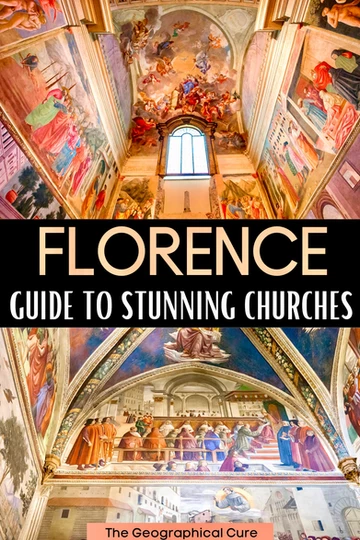Here’s my guide to the 16 most beautiful churches in Florence Italy. These church are some of the most stunning attractions in Florence, perfect for art lovers.
When it comes to art and architecture, Florence is a powerhouse. Florence is home to some of the world’s most beautiful churches from the Romanesque, Gothic, and Renaissance periods.
Florence’s churches are especially rich in Renaissance era decoration, from the greatest artists of the era — Michelangelo, Brunelleschi, Ghirlandaio, Giotto, and Giorgio Vasari.
For such a small city, there are a dizzying number of beautiful churches in Florence, over 100.
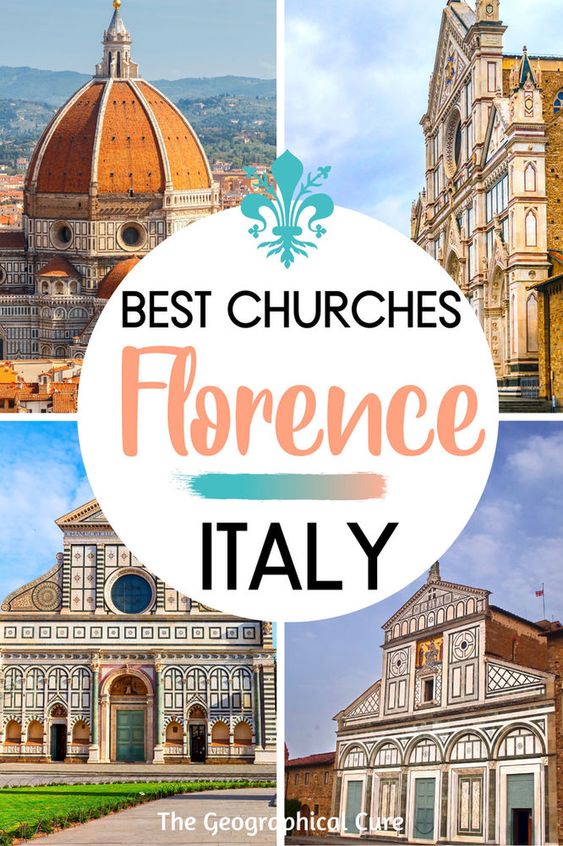
To give you some Florence destination inspiration, I’ve focused on what I think are the 15 most interesting and beautiful churches in Rome. These are the essential ones you should visit or put on your Florence itinerary.
From landmarks like the Cathedral and Santa Croce to lesser known beauties like San Lorenzo, San Miniato, and Santa Maria Novella, let’s have a look to these stunning buildings.
It doesn’t matter whether you’re religious. If you love art and architecture, you’ll be delighted by these magnificent churches in Florence.
Best Churches In Florence
Here are my picks for the best and most beautiful churches to visit in Florence. I tell you everything to see inside each church.
1. Florence Cathedral | Santa Maria del Fiore
Florence Cathedral is one of Italy’s most famous landmarks.
The Duomo is a magnificent structure that took 172 years to build, starting in 1296. The project was entrusted to the skilled architect Arnolfo di Cambio, who was responsible for creating many of the city’s prominent buildings in the 13th and 14th centuries.
The cathedral is officially known as the Cathedral of Santa Maria della Fiore, or St. Mary of the Flowers, and is a symbol of Florence, which translates to “lily flower” in Italian. Although there was no actual saint named St. Mary of the Flowers, the city’s nickname and symbol inspired the name of the cathedral.
Unlike the light and graceful Gothic style of Paris’ Notre Dame, Florence Cathedral’s Gothic architecture is characterized by brown sandstone and intricate facing of pink, green, and white marble, making it a striking sight to behold.
For two centuries, the Duomo was the largest (longest) cathedral in the world. Today, it’s the third largest behind St. Peter’s Basilica in Rome and St. Paul’s Cathedral in London.
Filippo Brunelleschi’s magnificent terra cotta colored dome, begun in 1418, is the highlight. Brunelleschi was the perfect balance of architect and engineer, visionary and traditionalist. His dome was almost as wide as the Pantheon in Rome. Inside, it’s decorated with frescos by Giorgio Vasari.
While Florence Cathedral is elegantly “frosted” with colored marble on the outside, inside Florence Cathedral is austere and almost empty. You might even wonder if it was ever finished.
The Duomo has an absolute must visit museum, the Opera del Duomo Museum. It’s housed in the Piazza del Duomo at the back of Giotto’s Bell Tower, and offers a nice view of the dome from its terrace.
Here’s my complete guide to visiting the Duomo in Florence. You may want to book a guided tour of the Duomo itself.
You can also book a guided tour of the Duomo that includes access to the dome and secret terraces that you wouldn’t see on a regular visit. It’s absolutely essential to pre-book a ticket to climb Brunelleschi’s dome.
2. Basilica of Santa Maria Novella
Santa Maria Novella is another of Florence’s most beautiful churches. It was founded in 1279 by a Dominican order. The basilica has a similar design to the Duomo and Santa Croce, with polychrome and white marble create a striking front facade.
The interior is a true marvel. It holds one of the most famous paintings in Italy, the Holy Trinity by Masaccio. Masaccio was an early Renaissance superhero, who tragically died young of malaria at only 27.
READ: Florence Art Bucket List
You’ll also want to visit both of the Strozzi Chapels. The Filippo Strozzi Chapel is to the right of the main altar. The other Strozzi Chapel is to the left up a flight of stairs.
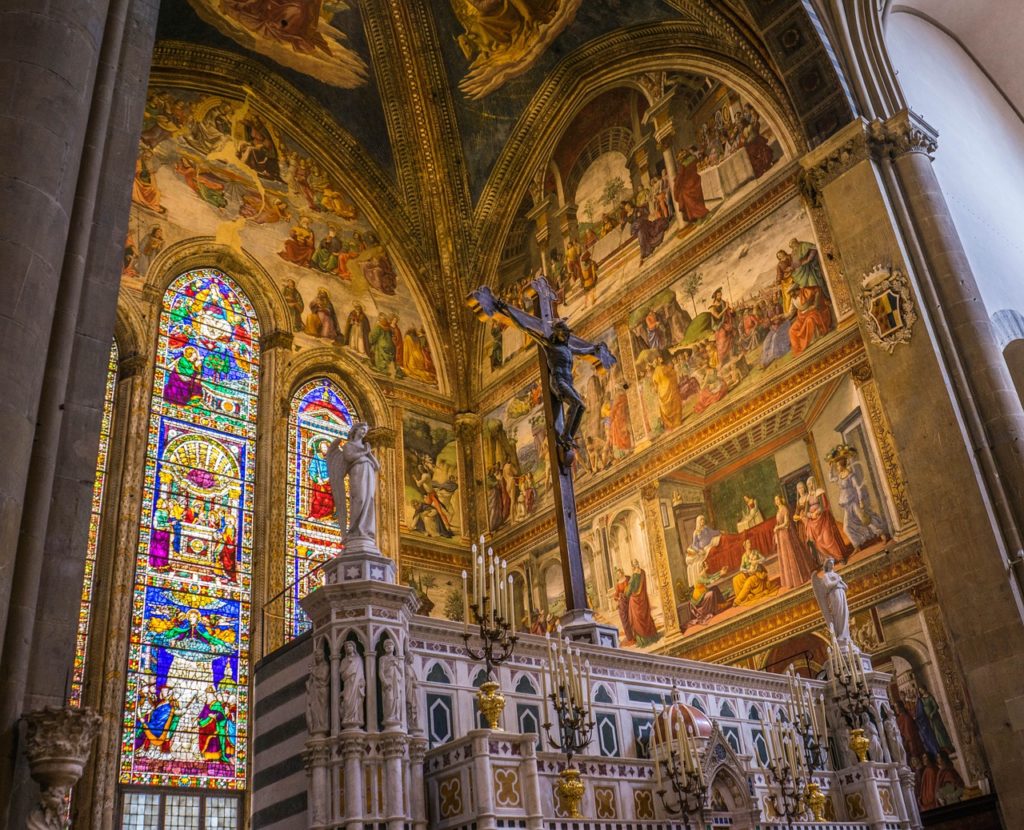
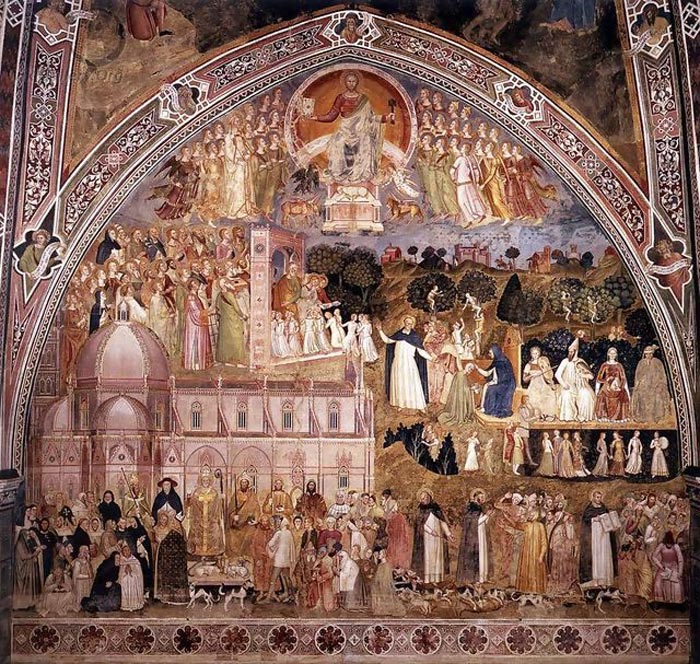
The Filippo Chapel contains precious frescos by Filippino Lippi, an early Renaissance luminary. The frescos, dating from 1502, depict the life of the apostles Philip and James.
The Tournabuoni Chapel contains another series of breathtaking frescos by Domenico Ghirlandaio and his young apprentice Michelangelo.
The other Strozzi Chapel belonged to another branch of the Strozzi family. It was decorated by Andrea Ocrana in the second half of the 14th century.
Another highlight of Santa Maria Novella is the Chapter House, erected around 1350, called the Spanish Chapel. It’s a bit of a hidden gem in Florence.
It’s a room completely covered with frescos by Andrea di Bonaiuto. The fresco cycle celebrates the spiritual and intellectual achievements of the Dominican order.
Here’s my complete guide to visiting Santa Maria Novella. Click here to book a skip the line ticket.
3. Basilica of Santa Croce
The Basilica of Santa Croce is a must visit church in Florence for lovers of Renaissance art. It dates from 1280. The basilica has one of the greatest assemblages of frescos, painting, sculpture, and funeral tombs in the world.
Santa Croce’s highlight is the frescos by Giotto, the greatest painter of the 14th century.
They’re found in the Bardi Chapel and the Peruzzi Chapel. In 1320-28, Giotto painted seven episodes from the life of St. Francis of Assisi, whom he personally identifed with.
READ: Guide To the Basilica of St. Francis of Assisi
There are also frescos by his students Taddeo and Agnolo Gaddi. The ones by Agnolo are well preserved and have been recently renovated.
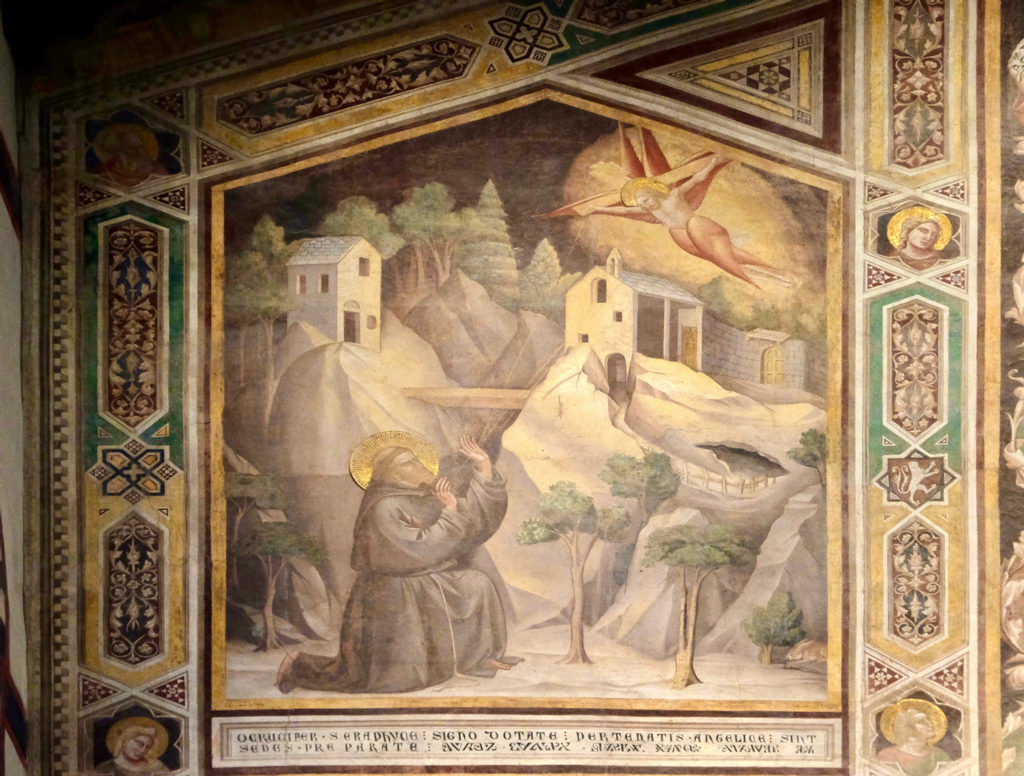
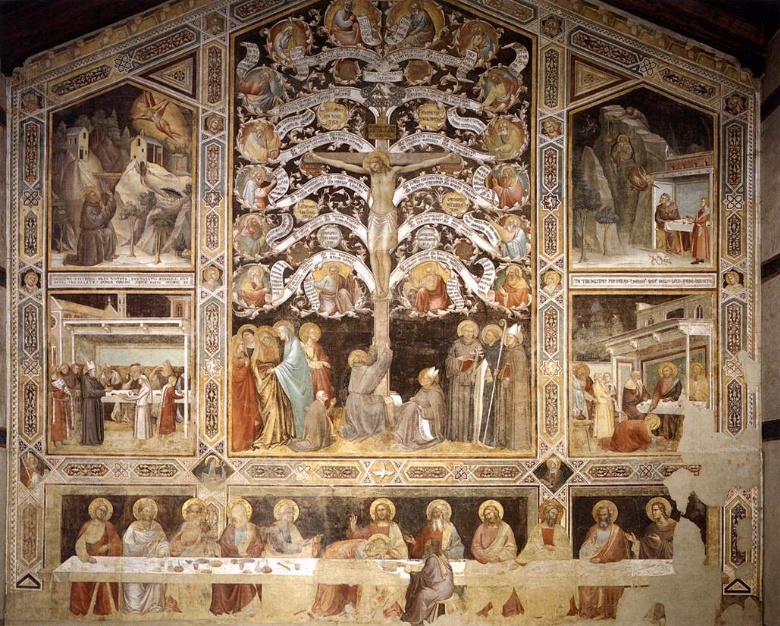
Santa Croce is also the resting place of storied Renaissance luminaries. You can find funeral tombs for Michelangelo, Ghiberti, Galileo, Dante, and Machiavelli.
Santa Croce also houses the famous Cimabue Crucifix and Giorgio Vasari’s The Last Supper Both were damaged in a devastating flood in 1966, but has been somewhat restored.
If you want more information, here’s my complete guide to visiting the Basilica of Santa Croce complex.
Click here to book a skip the line entrance ticket. You can also book a 1 hour guided tour.
4. Basilica of Santo Spirito
The Basilica of Santo Spirito is Brunelleschi’s second church in Florence. It sits in a shabby chic piazza in the Oltrarno district.
Built in 1440, the church is a pivotal work of the early Renaissance. Brunelleschi was one of the first architects to use perspective and geometry, breaking away from outdated medieval church styles.
Brunelleschi thought beauty resided in harmony and mathematical perfection.
He was inspired by the classicism of ancient Rome, creating an unassuming exterior and a rather severe interior. Brunelleschi used a latin cross (like a small t) floorpan.
The main altar, an out of place Baroque affair, is at the center of the crossing square. Three sides of Santo Spirito have a continuous succession of 40 identical semi-circular chapels.
The massive pietra forte Corinthian columns give the church a monumentality.
Santo Spirito houses a wooden crucifix attributed to Michelangelo. It was carved when he was only 17. Restored, it now hangs 22 meters high in the sacristy.
Santo Spirito’s old Augustinian refectory has an incredibly ancient The Last Supper fresco with a large crucifixion scene painted above it. But it’s in terrible condition and fragmented. Only a few of the apostles are partially conserved.
Another refectory contains a Last Supper fresco by Bernardo Poccetti from the 16th century.
5. Basilica of San Lorenzo
While Santa Croce holds the superior art collection, the beautiful Basilica of San Lorenzo is more famous. San Lorenzo was the official church of the Medici family. Michelangelo himself designed the simply stunning Medici Chapel between 1520-34.
The chapel’s coffered dome is similar to Rome’s Pantheon. The walls are clad with pink green, gold, and white marble.
There are two tombs decorated with allegories of the passage of time carved by Michelangelo — Dusk, Dawn, Day, Night. The sculpture of Night is regarded as one of Michelangelo’s finest works.
READ: Guide To the Michelangelo Trail in Florence
In 1527, Michelangelo returned to Florence to defend republican forces during a civil war. When Florence fell, Michelangelo retreated into a secret cell-like room below the Medici Chapel until he received confirmation of a pardon from Pope Clement VII, who was a Medici.
Michelangelo’s secret room wasn’t discovered until 1975, when a museum director spotted a trap door. The room contained charcoal sketches and doodles by Michelangelo on the walls, identified because they replicated his known works. The room opened to the public in 2020.
The other thing to see in San Lorenzo is the Chapel of the Princes. This is the main mausoleum for the Medici Family (Michelangelo’s Medici Chapel holds only the the remains of two lesser known Medici).
Cosimo de Medici commissioned it in 1568. But construction only began in 1602.
The chapel walls are clad with polychrome marble and precious stones. The cupola of the chapel features a fresco by Pietro Benvenuti. The sepulcher for Lorenzo the Magnificent is adorned with Michelangelo’s Madonna and Child sculpture.
Here’s my complete guide to visiting the Basilica of San Lorenzo complex and the Medici Chapel. Click here to book a skip the line ticket to the chapel. You can also book a 1.5 hour guided tour.
6. Basilica of San Miniato al Monte
If you’re at the Piazzale Michelangelo, you should walk 5 minutes and visit the spectacular and well preserved Church of San Miniato al Monte.
It’s Florence’s crowning glory, perched even higher and with a better view. Building began in 1018. Like the Baptistry, the church is over 1000 years old.
READ: Guide To the Florence Baptistery
The church takes its name from Minias, an Armenian prince who was Florence’s first martyr. Legend holds that Minias picked up his decapitated head and flew over the Arno to the church site. San Miniato Church is dedicated to the saint.
The relics of Minias are often said to be buried in the church crypt, which features frescos by Taddeo Gaddi.
But that’s inaccurate. The bones were sold off to raise money for the church. So I’m not sure what’s in the crypt besides chicken bones.
San Miniato has Florence’s emblematic white and green marble facade. It’s a harmonious piece of Tuscan Romanesque architecture, a very unique building in Florence.
When you walk through the turquoise doors, you’re greeted by a spectacular interior. Every inch of the church is covered in mosaics, gold leaf, or geometric patterns.
A spectacular mosaic decorates the half dome in the apse. The marble floor is decorated with zodiac signs.
The monks of San Miniato still sing Gregorian chants at Vespers in a small chapel at the back of the church. Anyone can go and listen. They usually chant at 5:30 pm in the summer and 4:30 pm in the winter.
There is no charge to enter the basilica. Click here to book a 2 hour guided tour.
7. Basilica of Santa Maria del Carmine
Santa Maria del Carmine was mostly destroyed by fire in 1771. Everything but the transept chapels and sacristy went up in flames. The Carmelite church was almost entirely reconstructed in high baroque style. You visit for the Brancacci Chapel.
The Brancacci Chapel is a supreme example of early Renaissance painting. It’s completely filled with frescos by Masaccio and his workshop.
It’s considered one of the three important chapels of the Renaissance, along with the Giotto’s Scrovegni Chapel in Padua and Michelangelo’s Sistine Chapel in the Vatican Museums.
Masaccio was an influential painter, despite dying mysteriously at just 27. He was one of the first painters in art history to experiment with single point perspective and three dimensional space.
A Medici enemy, Felice Brancacci, commissioned the fresco cycle in 1424. They were intended to represent the life of St. Peter, from original sin to the salvation of man. After Masaccio’s death, the frescos were completed by Fillipino Lippi.
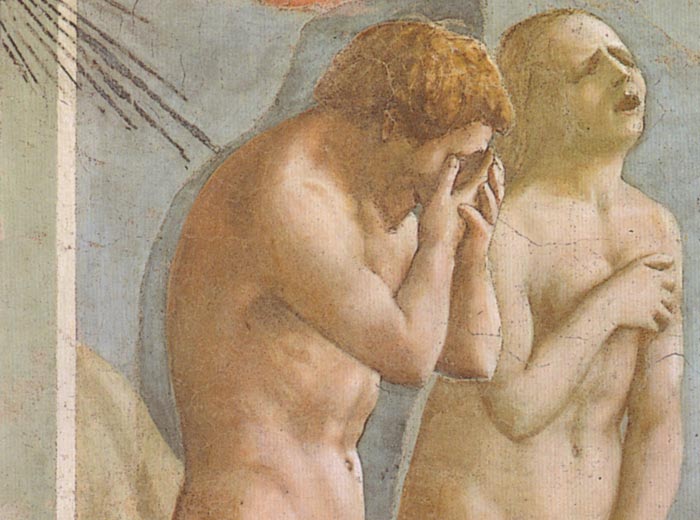
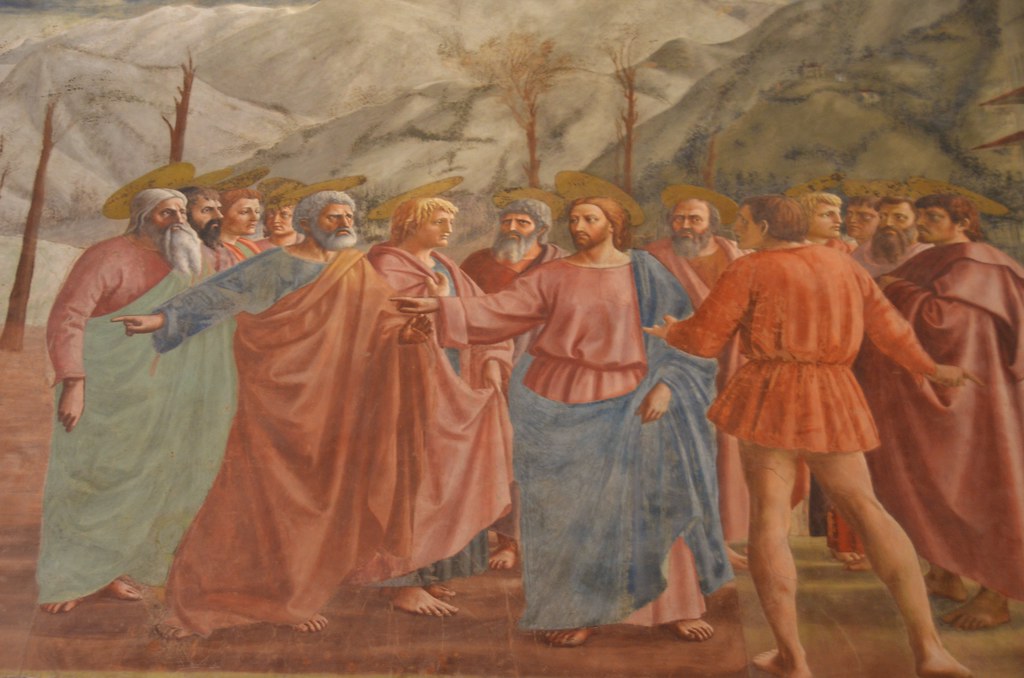
In the upper registry, there’s one of Masaccio’s greatest masterpieces, The Tribute Money. It’s a story from the New Testament when Christ is confronted by a tax collector. Christ performs a miracle, causing money to appear in the mouth of a fish.
Just to the left of The Tribute Money is another Masaccio must see masterpiece, the Expulsion of Adam and Eve From Eden. An armed angel banishes the pariahs. Adam appears ashamed and Eve cries. It’s an emotional painting.
Interestingly, Adam’s private parts were painted over with fig leafs on the order of the ultra religious Cosimo I in 1642, similar to Michelangelo’s Last Judgment in the Vatican Museums. During restoration, the figure of Christ was returned to the original nude.
Here’s my guide to visiting the Brancacci Chapel. Click here to book a ticket. You can also book a guided tour in English.
8. Church of the Annunciation | Santissima Annunziata
Santissima Annunziata was rebuilt in 1444-81 by the famed Florentine architect Michelozzo. It’s considered his masterpiece. This beautiful church in Florence also houses some superb works of Florentine art.
Inside, the nave was begun by Michelangelo in 1444 and completed in a different style by Leon Battista Alberti. After you enter, on the left, you’ll see an elegant tempietto marble temple by Michelozzo, which was commissioned to hold the miraculous picture of the Annunciation.
The tale goes like this. A 13th century monk, Fra Bartolomeo, fell asleep while painting an Annunciation. He awoke to find that angels had completed Mary’s face. The miracle drew pilgrims to the church.
You’ll find beautiful Andrea del Castagno’s frescos, Redeemer and St. Julian and Trinity. Another chapel has a panel by Perugino, Ascension of Christ. The sculptor Giambologna’s tomb is inside, adorned with frescoes, statues, and reliefs. And there’s a beautiful painting by Giorgio Vasari, Saint Luke Painting the Virgin.
In the cloister are the chapterhouse, several chapels, and the sacristy. The Votive Chapel boasts frescos by Andrea del Sarto, Cosimo Rosselli, Alesso Baldovinetti.
9. Church and Museum of Saint Salvatore of Ognissanti
Near the Arno River is one of the most fabulous churches in all of Florence — Ognissanti. The church and the convent were decorated by the greatest Early Renaissance masters of the times: Giotto, Botticelli, and Ghirlandaio.
The church was built in the 13th century. But it was completely remodeled in the 17th century in a Baroque style. Botticelli is buried here, along with his muse, Simonetta Vespucci.
There is some top notch art work for viewing in the church. The church originally held Giotto’s famous Ognissanti Madonna and Child Enthroned. But that painting was moved to the Uffizi Gallery.
You can still find Botticelli’s beautiful St. Augustine in His Study and Ghirlandaio’s St. Jerome and His Study, Madonna della Misericordia, and Lamentation.
READ: Guide To the Botticelli Trail in Florence
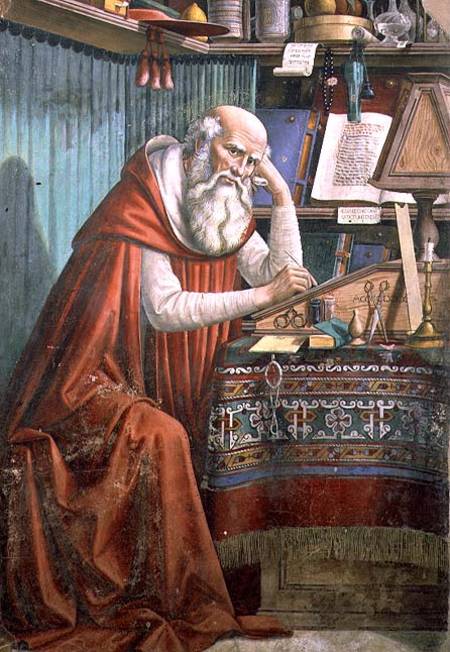
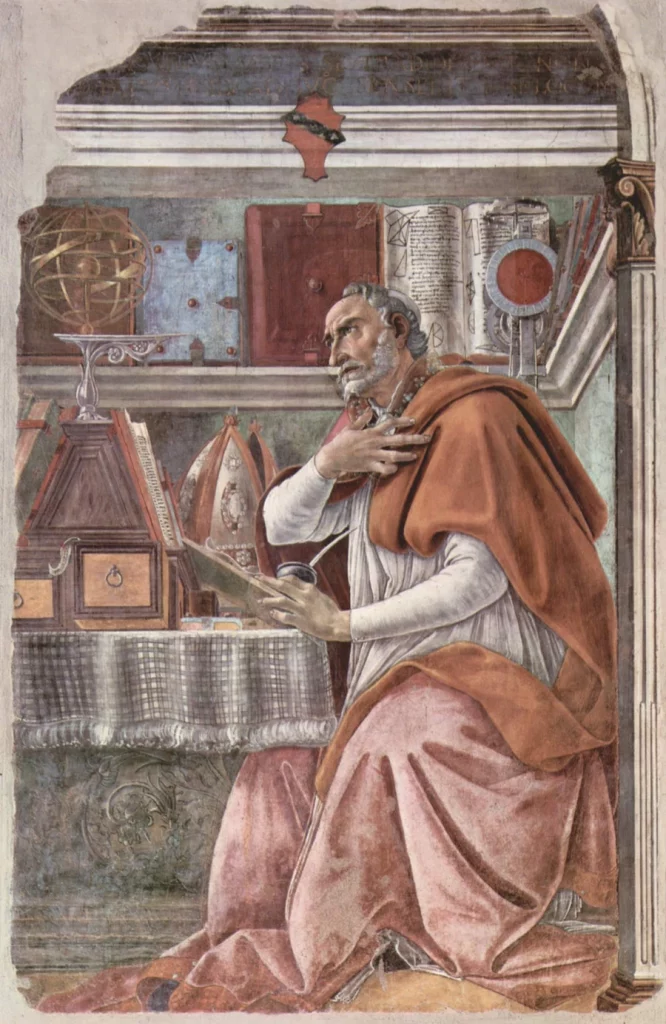
Founded in 1251, Ognissanti was part of a monastery that, initially, was open to men and women. The monastery was devoted to evangelical perfection, modesty, and manual labor. During Cosimo I’s reign, Franciscans took over the monastery in the 16th century.
The monastery was permanently closed in1866. Today, it’s a museum.
You can visit the cloisters, the chapter house, and the refectory.
The museum’s claim to fame is Ghirlandaio’s fresco of The Last Supper on the back wall of the refectory. You can only see it or four hours (9:00 am to 1:00 pm) on Mondays and Saturdays.
10. Orsanmichaele | San Michele in Orto
Designed by Francesco Talenti and others, Orsanmichele is a well preserved and important 15th century Florentine church.
It’s eccentric looking. Orsanmichele rises up like a three story brown rectangle.
But it’s a treasure trove of Renaissance sculpture — a sort of street view museum. Orsanmichele was originally Florence’s central grain market. It was converted into a church in 1380.
Inside, the church has a spectacular bejeweled Gothic Tabernacle altar, with a painting of the Madonna della Grazie.
Legend holds that those who prayed before her were granted miracles. The original painting was lost and replaced with a 1497 painting by Bernardo Daddi.
Orsanmichele is most noted for its incredible sculpture, decorating the exuberant Gothic facade. The facade has 14 niches, each one housing a statue of a patron saint commissioned by Florence’s guilds.
Created by the best artists of the time, the exterior sculptures are now copies. The monumental originals are in the Orsanmichele Museum on the top floor of the church.
By far, Orsanmichele’s most famous sculpture is Donatello’s St. Mark. It’s the first truly Renaissance piece of art (sculpture was more advanced than painting). St. Mark marked a revival of classical themes and naturalism.
11. Church of Santa Trinita
If you walk down Florence’s most elegant street, Via Tornabuoni, you’ll come to the Church of Santa Trinita.
Located in front of the piazza, Santa Trinita is a Roman Catholic Church and the birthplace of the Vallumbrosan Order. Originally built in a simple Romanesque style, it was later restored in a Gothic style.
Santa Trinita is extremely rich in artworks. Most of them are on display in the chapels. The Sasseti chapel is by far the most important chapel.
In it, Ghirlandaio painted scenes from the life of St. Francis. Ghirlandaio also created the chapel’s altarpiece, Adoration of the Shepards.
You’ll also find frescos by Rossellini and a Mary Magdalene sculpture that looks like Donatello’s work, which is in the Duomo museum.
12. Sant’Apollonia
Sant’Apollonia is a museum dedicated to a single work of art — Andrea del Castagno’s The Last Supper. It’s an almost unknown masterpiece. This huge beauty covers one wall in the refectory of Florence’s 15th century Sant’Apollonia convent, near San Marco Monastery.
The Cencalo Sant’Apollonia is a free museum, funded by the Italian state, at least for now. When you walk through the unassuming door, you leave your signature with the custodian and can enjoy sublime art without the crowds.
Castagno was part of the second generation of the early Renaissance period. As a painter, he was inspired by sculpture, particularly by the work of Donatello. His The Last Supper is a painting Leonardo probably knew, studied, and tried to move beyond. It’s considered the first fully Renaissance Last Supper.
READ: Vistor’s Guide To Leonardo’s The Last Supper In Milan
Tremendous in its own right, Castagno’s painting imparts incredible spiritual power. It’s a wildly exciting illusory mix of forced geometric perspective, exaggerated horizontality, metaphysical symbolism, and episodic herky-jerkiness.
The overall optical effect is like seeing a hallucinogenic inlaid marble table from above. There’s no light source, windows, or central majestic Jesus, so the eye darts about this uncentered mazy space.
13. Church of Dante | Church of Santa Margherita de’ Cerchi
For fans of Italian literature and especially the great Dante Alighieri, this tiny church in Florence should be on your Florence bucket list along with Dante’s house. The church is tiny, hidden between huge buildings.
The Church of Santa Margherita de’ Cerchi dates back to the 11th century. This is the spot where Dante met his true love Beatrice.
Dante wrote about his instant and idealized love for her in Vita Nuova. He said “Behold, a deity stronger than I; who coming, shall rule over me.” Dante loved her from afar the rest of her life. In his Divine Comedy, a literary masterpiece, Beatrice is Dante’s guide on his pilgrimage through hell, purgatory, and paradise.
Although Beatrice’s family and nanny are buried in the church, she was probably buried somewhere else with her husband’s relatives. But, even now, Dante fans leave letters for Beatrice at her tomb in the church.
14. Chapel of the Magi | Capella dei Magi
The Chapel of the Magi is located in the Medici-Riccardi Palace, the first of three palaces that the Medici family lived in. The palace itself is rather a brooding rusticated stone affair.
But upstairs in the Piano Nobile hides one of the most precious hidden gems in Florence — the Chapel of the Magi. The chapel is accessed via a stairway from the courtyard.
The Chapel of the Magi was a private chapel used exclusively for the Medici’s prayer and devotion.
The chapel is decorated with an absolutely beautiful series of frescos painted in 1459 by Benozzo Gozzoli. Gozzoli was trained by Ghiberti and Fra Angelico, and thus developed a charming narrative style.
READ: Guide To The Most Beautiful Chapels in Italy
The frescos are in two parts, the Procession of the Magi on three walls in the main room and the Adoration of the Magi in the chancel. The frescos are meant to glorify the Medici family.
It was a form of propaganda to show their wealth and greatness. Throughout the chapel, there’s an abundance of purple porphyry and gold, just to underscore the point.
The Procession of the Magi covers three of the four chapel walls. Each wall represents one of the three kings or magi arriving in Bethlehem to pay homage to the newborn king, bringing expensive gifts.
Famous Medici appear in the guise of the magi, equating themselves with immortality.
15. Oratorio dei Buonomini di San Martino
This 700 year old Florence church is an important medieval complex. The church, which can be visited for free, was the home of the Confraternity of the Buonomini di San Martino.
Buonomini literally translates as “good men.” A confraternity was an association of lay people who gathered together to pray and do charitable works.
Saint Martin of Tours is the saint most often associated with charity. Legend holds that he divided his cloak in two to share it with a beggar.
In the Buonomini’s oratory, the saint is represented in 2 frescoed lunettes, while 8 other lunettes represent the various works and good deeds of the charitable Buonomini men.
The lunettes were painted by an unknown artist in the school of Ghirlandaio in the early 1480s. They are similar style to the frescoes in the high chapel of Santa Maria Novella.
16. San Marco Monastery
I’ve saved one of my favorite and best churches in Florence for last, San Marco Monastery. The monastery is a church and a convent. The convent is now a museum, which is an extraordinary decorative complex.
San Marco was the first ever Renaissance style convent in Florence. It was built on the site of two decaying medieval monasteries during 1438-43. For this important job, Cosimo hired the architect Michelozzo to rebuild the monastery.
At this Renaissance convent-museum, you travel back in time to a nearly perfectly preserved 600 year old Dominican monastery.
It was paid for by Medici family money, designed by the stellar architect Michelozzo, and decorated with delicate frescos by one of the most sublime painters of the Renaissance — Fra Angelico. The fiery preacher Girolamo Savonarola even lived there.
The Sala dell’Ospizio or the Hospice Room is a highlight of the museum, housing the world’s best Fra Angelico panel paintings, from monumental altarpieces to small works.
As you head upstairs to the monks’ dormitories, you’ll find one of the Renaissance’s most famous paintings, Fra Angelico’s The Annunciation.
You can also visit the actual monks cells. There are 43 cells with low ceilings arranged along three corridors. Each room has a customized devotional fresco.
Here’s my complete guide to San Marco Monastery. Click here to book a skip the line ticket. Click here to book a 2 hour guided tour.
I hope you’ve enjoyed my guide to the best and most beautiful churches in Florence You may enjoy these other Florence travel guides and resources:
- 1 day itinerary for Florence
- 3 day itinerary for Florence
- Best museums in Florence
- Hidden gems in Florence
- Must see sites in Florence
- Florence art bucket list
- Best day trips from Florence
- Guide to the Medici Palaces
- Guide to the Uffizi Gallery
- How To Visit the Duomo
If you’d like to explore Florence’s amazing churches, pin it for later.

